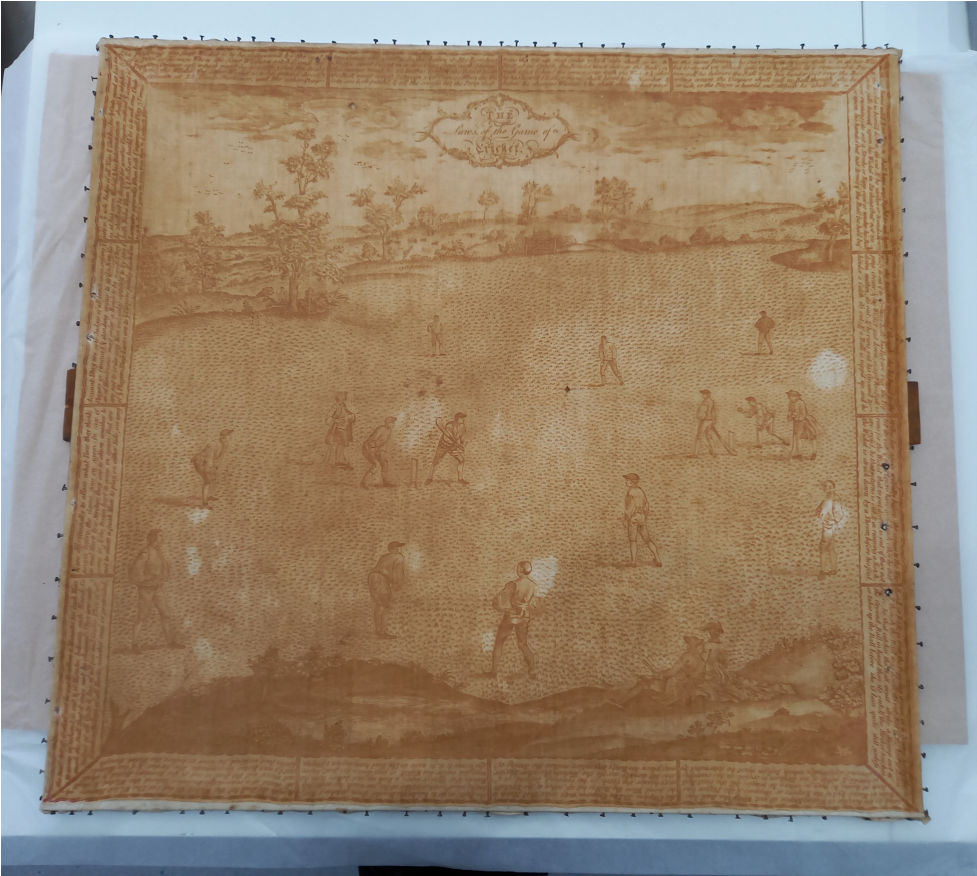On display in Gallery One of the Museum is a large handkerchief, dating from the 1760s, which shows the laws of cricket as they existed in books and magazines from 1752. The handkerchief on display has been fully restored and is on display for the first time in the Museum. Inscribed in the bottom right corner are the words Jos Ware, Cranford indicating the name and location of the factory that produced the handkerchief.
Such large handkerchiefs which were often seen hanging out of gentlemen’s pockets in 18th-century paintings and were used mainly in connection with the habit of taking snuff were decorated with all sorts of topical subjects, including sporting pastimes. The use of handkerchiefs for hygienic purposes was confined to the upper echelons of society, and given they were often made of the finest silks and linen, were increasingly made and used for decorative or commemorative purposes. The very early handkerchiefs were made of silk or linen with a cricket theme and were produced by Joseph Ware of Crayford in Kent and showed the earliest printed laws of the game. Joseph Ware took over a calico works in Crayford in 1757 and ran the firm until 1769. Just four of the handkerchiefs produced at the Ware factory are still in existence and Col. RS Rait Kerr in The Laws of Cricket Their History and Growth (1950) concludes that the handkerchief in the Sussex Cricket Museum is the earliest of the four produced by the Crayford factory to have survived. One is in the museum at Melbourne Cricket Club, two are in the museum at Lord’s and the other will be on display in the Sussex Cricket Museum for the first time in readiness for the 2024 season.
Such handkerchiefs remained fashionable but by the 19th century, printed handkerchiefs woven on Jacquard looms were plentiful. In 1804 Joseph-Marie Jacquard, a French weaver and merchant invented a machine which made it possible to produce complex and detailed patterns in a factory by unskilled workers. The spread of mass-produced handkerchiefs led to a decline in the demand for the type of handkerchiefs that had been manufactured by the Ware factory. Jacquard produced handkerchiefs could now be mass produced and bought cheaply by a much wider section of society.

Very few handkerchiefs have survived from the 18th century. In the 1940s cricket collector JW Goldman doubted whether there were more than a dozen different cricket handkerchiefs in existence.
All four handkerchiefs produced by the Ware factory in Crayford are based on a print by Charles Grignion of a game being played on Mary-le-bone Fields, and on sale in 1748. The print by Grignion was based on a painting by London based Francis Hayman. It shows a cricket match in progress with 13 players, two umpires and two spectators. Ground and foliage feature in the foreground and background, with the sky above. The image is framed by the original Laws (second edition). The figures were probably painted by Hayman, but he used to employ others to paint the background so the setting for the game could be anywhere. The fielders seem to be more concerned with each other rather than with the bowler and batsman and are almost certainly individual portraits with the one on the right most likely Hayman himself.
The Museum’s handkerchief was at one time owned by Chichester cricketer Daniel King who on his deathbed in 1836 passed it on to Sussex cricketer William James Humphry of Donnington. Humphry passed the handkerchief on to his son, Gilbert William (1850-1933) since when the handkerchief has been in the possession of the Museum.